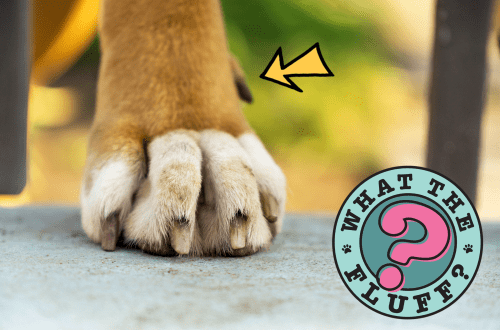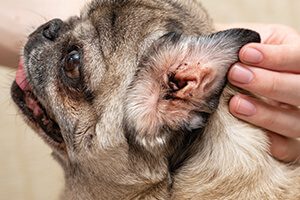
Ear mites in dogs: symptoms, treatment, photos
Contents
- What is an ear mite
- How can a dog get ear mites?
- Which animals are at risk
- Does the disease depend on the time of year
- Ear mites symptoms
- Photo of an ear mite
- Diagnostics
- Can you spot ear mites at home?
- Treatment
- How to prepare a dog’s ear for treatment
- Why are ear mites dangerous in dogs?
- Can a person get ear mites from a dog?
- Prevention
What is an ear mite
What does a parasite look like? This is a very small insect, not reaching one millimeter, with a grayish-white translucent body, which has a gnawing mouth apparatus. It gnaws through the skin and makes passages under it, laying eggs in them.
Ear mites under the microscope
The wounds become inflamed and fester. The larvae, feeding on suppuration products and lymphatic fluid, reach sexual maturity after 3-4 weeks, and then also lay eggs. In a short period of time, an ear mite can damage not only the skin of the dog’s ear, but also the eardrum, and penetrate further into the inner ear and brain.
The disease develops imperceptibly – when the animal begins to show signs of the presence of a tick, then, as a rule, a significant part of the ear is affected. In addition, it has been noted that the activity of the insect is subject to some cyclicity: the period of activity and vivid symptoms are replaced by more or less calm intervals. Perhaps this is due to the cyclic development of the parasite. When the pathology takes on threatening forms, there are no periods of rest.
How can a dog get ear mites?
The ear mite can be transmitted from one animal to another, no matter what stage of development it is at. During the itch, the dog intensively scratches the ears, contributing to the spread of the parasite over the entire surface of the body. That is, the tick and its transitional forms can be located anywhere where the pet is located.
A healthy animal can “catch” an ear mite in the following ways:
- upon contact (even fleeting) with a carrier animal;
- through the care item used by the infected dog;
- from a person who was in contact with the affected representative;
- through fleas (they can carry tick larvae);
- from the mother (in puppyhood).
Which animals are at risk
It has been established that the ear mite most often “attacks” young dogs that have not reached six months. The disease is characterized by a severe course and the development of complications.
Four-legged friends with long ears have an increased susceptibility to the parasite. Among them: dachshunds, spaniels, Yorkies. Dogs of hunting breeds are a special risk group – they can become infected with a tick not only from other relatives, but also from wild animals.
Does the disease depend on the time of year
The ear mite can “cling” to a pet at any time of the year – unlike ixodid ticks, this parasite is also active in the winter. Their reproduction does not depend on air temperature, daylight hours and other conditions. Since they live in the ear canal, they do not have a dormant period. This means that the owner must be alert even in severe frost, avoiding contact between his pet and other dogs.
Ear mites symptoms
You can suspect an ear mite in a dog if a dirty brown mass is found in the external auditory canal. It is formed from skin scales, particles of the outer integument of shed parasites, and the secretion of the ear glands. All this is mixed with purulent secretions from damaged areas of the epidermis and excrement of ticks, and leads to severe skin irritation and inflammation.
Other symptoms of ear mites:
- hyperemia of the skin of the ear canal;
- severe itching;
- swelling of the ear folds.
The dog is nervous, shakes his head, often itches. When combing and while shaking the ears, particles of the accumulated mass can fly out of the external auditory canal.
Photo of an ear mite
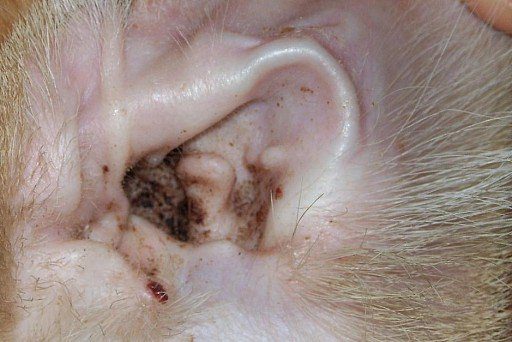
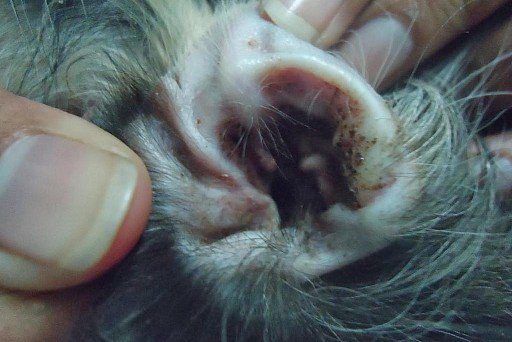
Diagnostics
Diagnosis of ear mites in dogs is not difficult: during the examination, the veterinarian will take material from the ear and look at it under a microscope. In the chronic form, bacterial culture of the contents of the auditory canal may be required to determine the sensitivity of the insect to medicinal substances and to select the optimal drug. In advanced cases, a specialist may prescribe an x-ray examination or computed tomography to identify the condition of the inner ear and meninges. Among the additional diagnostic procedures, it should be noted: bacterial analysis, scrapings, allergic tests.
Can you spot ear mites at home?
There are situations when it is not possible to conduct a microscopic examination of a dog in a clinic. Before treating a pet for otodectosis, you can independently identify the parasite at home. To do this, you need a cotton swab, a piece of dark-colored paper and a magnifying glass. Taking a little plaque from the pet’s external auditory canal with a stick, you need to put it on paper. In the presence of a disease under a magnifying glass, you can see moving ticks of a light gray hue.
Important: at the initial stages of the development of pathology, the population may be small. Therefore, the likelihood that insects will be in the material taken is reduced.
Treatment
Treatment of ear mites in dogs is based on the mandatory use of medications. Without the use of drugs to get rid of the parasite will not work. The owner should be patient, as the process can take a long time. Since insect larvae persist in the environment, careful treatment of the premises in which the dog lives, as well as items for her care, will be required to prevent re-infection.
Medication Therapy
Preparations for the treatment of otodectosis in dogs differ in composition, manufacturer, form of release, price and other parameters. It is not recommended to buy a product at random: before removing the parasite, you need to consult a specialist.
The most popular drugs for ear mites in dogs are presented in the table.
Name
Form of issue
Active ingredient
Price, rub)
Feature of application
Amit
Drops
Amitraz
80
Definitely in both ears. Suitable for cats.
Ivermek
Gel
Ivermectin
400
Suitable for other animals
Otovedin
Drops
Phytocomplex
60
Used to clean the ear canal
Decor-2
Drops
Permethrin
80
In both ears
Leopard
Drops
Diazinon
100
It has anti-inflammatory effect
Tzipam
Drops
Cypermethrin, amitraz
150
Good for fleas and other insects
Acaromectin
Spray
Ivermectin
150
Suitable for demodicosis, fleas, lice and other parasites
Amidel
Gel
Amitraz, Lidocaine, Methyluracil
180
Has an analgesic and regenerating effect
Decta
Drops
Fipronil, lidocaine, chloramphenicol
120
Eliminates inflammation and pain.
Traditional methods of treatment
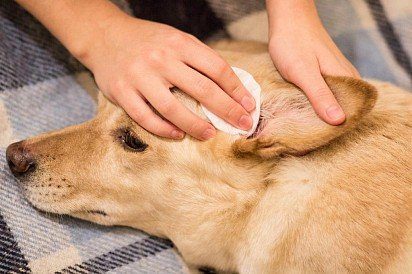
Treatment for ear mites in dogs
Sometimes dog owners use folk remedies to rid their pet of ear mites. Compositions based on kerosene and vegetable oil, oil and iodine, strong tea are popular. Sometimes vegetable oil is mixed with garlic juice. This approach to the treatment of otodectosis cannot be considered correct. Firstly, such compounds, if they can help, then only at the very early stage of the development of the disease, when the number of ticks is low.
Secondly, garlic juice, kerosene, iodine have a strong irritating effect on the animal’s skin. The application of these components to the damaged cover can lead to burns, and if penetrated into the inner ear, lead to complete deafness.
How to prepare a dog’s ear for treatment
Before dripping drops from an ear mite, it is necessary to clean the pet’s ears from the accumulated mass. If the dog resists (not all animals tolerate this procedure stoically, especially if they are in pain), it is best to do the procedure with two people. For small sizes, you can throw a blanket over it or wrap it in a towel. If the pet is large, a muzzle should be used.
In the process of cleaning, you must adhere to the following recommendations.
- You need to use sticks, not cotton swabs or discs, as there is a risk of pushing the accumulated mass deep into the ear canal.
- Cleaning should begin with areas located close to the edges of the ear, gradually moving deeper.
- The movements of the wand should be outward.
- If the masses are dry, you can wet the cotton end with peroxide or chlorhexidine. You can’t put them in your ear.
- It is advisable to use lotions specially designed for this purpose for cleaning the ears.
- If long hair grows on the dog’s ears, then it must be cut off for the period of treatment.
Why are ear mites dangerous in dogs?
The lack of treatment of ear mites in dogs leads to the development of complications:
- blockage of the ear canal;
- accession of a secondary infection;
- inflammation of the middle and inner ear;
- damage to the eardrum;
- deafness;
- mental disorders;
- the transition of the inflammatory process to the brain;
- death of a pet.
Can a person get ear mites from a dog?
Maybe. Although rare, cases of development of otodectosis in humans also occur. The symptoms of the disease are the same: itching, inflammation, swelling of the ear canal, accumulation of waste products of insects.
Prevention
It is impossible to completely prevent an ear mite infestation in your pet. However, with the help of preventive measures, you can reduce the likelihood of developing the disease. For this you need:
- avoid contact of the dog with unfamiliar relatives;
- periodically carefully examine the animal;
- if you find brown plaque in your four-legged friend’s ears, visit the clinic as soon as possible and undergo an examination;
- periodically carry out preventive cleaning with special preparations, which are selected together with a veterinarian, taking into account contraindications and other nuances.
The disease has a favorable prognosis, provided timely detection and proper treatment. At the very beginning of the development of otodectosis, it happens that the ear mite disappears after one procedure of cleansing and using the drug. In advanced cases, you need to be patient, follow the rules of hygiene of the pet’s ears, adhere to the therapy regimen, and increase the dog’s immunity.



